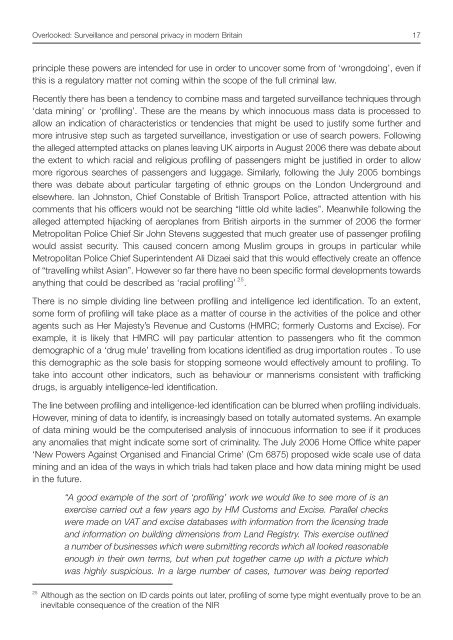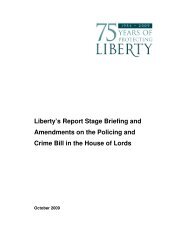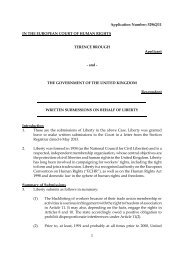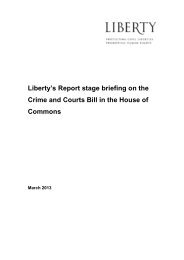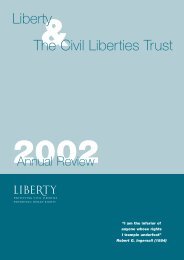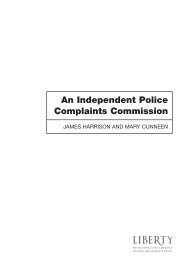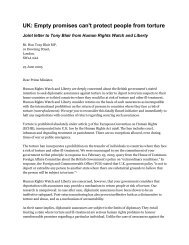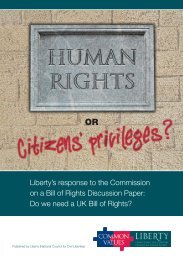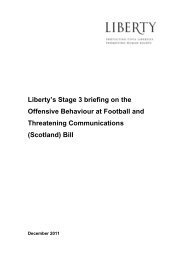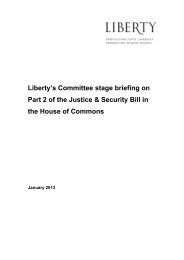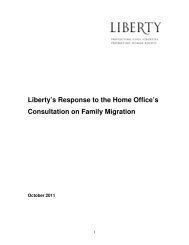Overlooked - Liberty
Overlooked - Liberty
Overlooked - Liberty
You also want an ePaper? Increase the reach of your titles
YUMPU automatically turns print PDFs into web optimized ePapers that Google loves.
<strong>Overlooked</strong>: Surveillance and personal privacy in modern Britain 17<br />
principle these powers are intended for use in order to uncover some from of ‘wrongdoing’, even if<br />
this is a regulatory matter not coming within the scope of the full criminal law.<br />
Recently there has been a tendency to combine mass and targeted surveillance techniques through<br />
‘data mining’ or ‘profiling’. These are the means by which innocuous mass data is processed to<br />
allow an indication of characteristics or tendencies that might be used to justify some further and<br />
more intrusive step such as targeted surveillance, investigation or use of search powers. Following<br />
the alleged attempted attacks on planes leaving UK airports in August 2006 there was debate about<br />
the extent to which racial and religious profiling of passengers might be justified in order to allow<br />
more rigorous searches of passengers and luggage. Similarly, following the July 2005 bombings<br />
there was debate about particular targeting of ethnic groups on the London Underground and<br />
elsewhere. Ian Johnston, Chief Constable of British Transport Police, attracted attention with his<br />
comments that his officers would not be searching “little old white ladies”. Meanwhile following the<br />
alleged attempted hijacking of aeroplanes from British airports in the summer of 2006 the former<br />
Metropolitan Police Chief Sir John Stevens suggested that much greater use of passenger profiling<br />
would assist security. This caused concern among Muslim groups in groups in particular while<br />
Metropolitan Police Chief Superintendent Ali Dizaei said that this would effectively create an offence<br />
of “travelling whilst Asian”. However so far there have no been specific formal developments towards<br />
anything that could be described as ‘racial profiling’ 25 .<br />
There is no simple dividing line between profiling and intelligence led identification. To an extent,<br />
some form of profiling will take place as a matter of course in the activities of the police and other<br />
agents such as Her Majesty’s Revenue and Customs (HMRC; formerly Customs and Excise). For<br />
example, it is likely that HMRC will pay particular attention to passengers who fit the common<br />
demographic of a ‘drug mule’ travelling from locations identified as drug importation routes . To use<br />
this demographic as the sole basis for stopping someone would effectively amount to profiling. To<br />
take into account other indicators, such as behaviour or mannerisms consistent with trafficking<br />
drugs, is arguably intelligence-led identification.<br />
The line between profiling and intelligence-led identification can be blurred when profiling individuals.<br />
However, mining of data to identify, is increasingly based on totally automated systems. An example<br />
of data mining would be the computerised analysis of innocuous information to see if it produces<br />
any anomalies that might indicate some sort of criminality. The July 2006 Home Office white paper<br />
‘New Powers Against Organised and Financial Crime’ (Cm 6875) proposed wide scale use of data<br />
mining and an idea of the ways in which trials had taken place and how data mining might be used<br />
in the future.<br />
“A good example of the sort of ‘profiling’ work we would like to see more of is an<br />
exercise carried out a few years ago by HM Customs and Excise. Parallel checks<br />
were made on VAT and excise databases with information from the licensing trade<br />
and information on building dimensions from Land Registry. This exercise outlined<br />
a number of businesses which were submitting records which all looked reasonable<br />
enough in their own terms, but when put together came up with a picture which<br />
was highly suspicious. In a large number of cases, turnover was being reported<br />
25<br />
Although as the section on ID cards points out later, profiling of some type might eventually prove to be an<br />
inevitable consequence of the creation of the NIR


